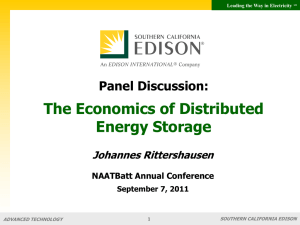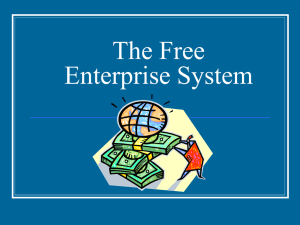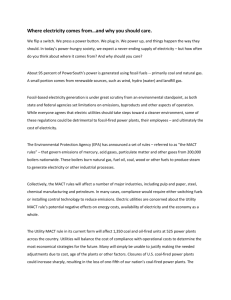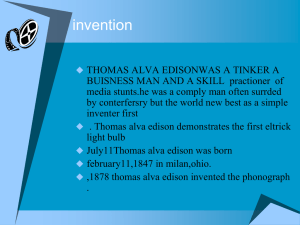fact sheet - Duke Energy
advertisement
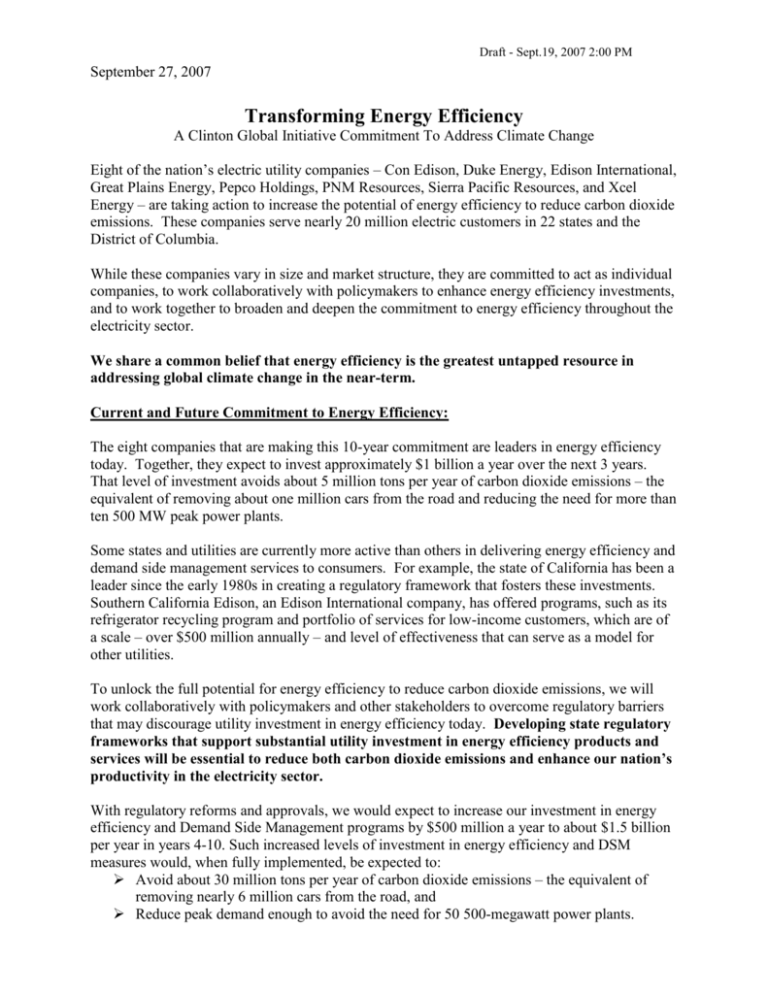
Draft - Sept.19, 2007 2:00 PM September 27, 2007 Transforming Energy Efficiency A Clinton Global Initiative Commitment To Address Climate Change Eight of the nation’s electric utility companies – Con Edison, Duke Energy, Edison International, Great Plains Energy, Pepco Holdings, PNM Resources, Sierra Pacific Resources, and Xcel Energy – are taking action to increase the potential of energy efficiency to reduce carbon dioxide emissions. These companies serve nearly 20 million electric customers in 22 states and the District of Columbia. While these companies vary in size and market structure, they are committed to act as individual companies, to work collaboratively with policymakers to enhance energy efficiency investments, and to work together to broaden and deepen the commitment to energy efficiency throughout the electricity sector. We share a common belief that energy efficiency is the greatest untapped resource in addressing global climate change in the near-term. Current and Future Commitment to Energy Efficiency: The eight companies that are making this 10-year commitment are leaders in energy efficiency today. Together, they expect to invest approximately $1 billion a year over the next 3 years. That level of investment avoids about 5 million tons per year of carbon dioxide emissions – the equivalent of removing about one million cars from the road and reducing the need for more than ten 500 MW peak power plants. Some states and utilities are currently more active than others in delivering energy efficiency and demand side management services to consumers. For example, the state of California has been a leader since the early 1980s in creating a regulatory framework that fosters these investments. Southern California Edison, an Edison International company, has offered programs, such as its refrigerator recycling program and portfolio of services for low-income customers, which are of a scale – over $500 million annually – and level of effectiveness that can serve as a model for other utilities. To unlock the full potential for energy efficiency to reduce carbon dioxide emissions, we will work collaboratively with policymakers and other stakeholders to overcome regulatory barriers that may discourage utility investment in energy efficiency today. Developing state regulatory frameworks that support substantial utility investment in energy efficiency products and services will be essential to reduce both carbon dioxide emissions and enhance our nation’s productivity in the electricity sector. With regulatory reforms and approvals, we would expect to increase our investment in energy efficiency and Demand Side Management programs by $500 million a year to about $1.5 billion per year in years 4-10. Such increased levels of investment in energy efficiency and DSM measures would, when fully implemented, be expected to: Avoid about 30 million tons per year of carbon dioxide emissions – the equivalent of removing nearly 6 million cars from the road, and Reduce peak demand enough to avoid the need for 50 500-megawatt power plants. Draft - Sept.19, 2007 2:00 PM The most appropriate regulatory reforms may vary from state to state. Duke Energy, for instance, has proposed an innovative ‘save a watt’ energy efficiency program, which would reward the utility for undertaking aggressive expansion of energy efficiency and DSM measures in lieu of building new power plants. Institute for Electric Efficiency: Sharing Best Practices To spark broad-based innovation throughout the electricity sector on energy efficiency, we are supporting, with the Edison Electric Institute, the formation of a new organization -- the Institute for Electric Efficiency (IEE). The IEE will promote the sharing of information, ideas and experiences on effective means of delivering energy efficiency. The Institute for Electric Efficiency will provide a forum to: Share case studies and expert information on technologies, program designs, and financial arrangements for effectively delivering energy efficiency Convene conferences and seminars to promote the sharing of information, ideas and experiences in energy efficiency in the power sector, and Develop a resource base of effective regulatory models and options for supporting investments in energy efficiency. The institute will welcome the participation of all sectors of the electricity industry and other interested parties who share our commitment to enhancing the nation’s electric efficiency. About the Companies: Con Edison provides electric, gas and steam services to residents and businesses in New York City and Westchester County, including 3.2 million electric customers and 1.1 million gas customers. In support of New York City and state policy, Con Edison has proposed achieving at least 500 megawatts of permanent demand reduction by 2016 through significant energy efficiency initiatives and targeted demand-side management programs in the company's service area. "Every step we take to reduce energy consumption, whether by installing more efficient lighting or encouraging alternative cooling systems, benefits the environment," said Con Edison Chairman and CEO Kevin Burke. Duke Energy serves 4 million electric customers in the Carolinas and Indiana, Ohio and Kentucky, and has proposed an innovative “save-a-watt” plan that makes energy efficiency the company’s fifth fuel in meeting customer power demand, along with advanced nuclear, clean coal, natural gas and renewable energy. The save-a-watt model is the first of its kind in the industry – and treats energy efficiency as a production cost by allowing utilities to earn money based on the actual watts saved, rather than only on the amount of power sold. “Our engineers would wake up every day thinking about how to squeeze more productivity from technology rather than having to focus on building more power plants,” said Duke Energy CEO Jim Rogers. Southern California Edison, an Edison International company, is the largest electric utility in California. SCE serves a population of more than 13 million via 4.8 million customer accounts in a 50,000-square-mile service area within central, coastal and Southern California. SCE has a wide variety of energy efficiency programs, from refrigerator recycling for residents to rebates for residents and businesses, and a portfolio of services for low-income customers. These and Draft - Sept.19, 2007 2:00 PM other programs that help customers control their energy usage and save energy, money and the environment total more than $500 million annually. “Our programs lead the nation in energy efficiency and serve as a model for other utilities,” said John E. Bryson, chairman and chief executive officer of Edison International. Great Plains Energy, headquartered in Kansas City, Mo., is the holding company for Kansas City Power & Light (KCP&L), a leading regulated provider of electricity in the Midwest, and Strategic Energy, LLC, a competitive electricity supplier. Both companies help customers save energy and money while reducing their carbon footprint. KCP&L is committed to helping its 505,000 Kansas and Missouri customers through a number of energy efficiency programs. Through these innovative programs KCP&L will avoid 181 megawatts of capacity and 62 gigawatt hours of energy by 2010. At least one-half of KCP&L's expected load growth will be offset by these energy efficiency programs. Pepco Holdings, Inc. (PHI) is one of the largest energy delivery companies in the Mid-Atlantic, serving about 1.8 million customers in Delaware, the District of Columbia, Maryland, New Jersey and Virginia. PHI’s Blueprint for the Future is our plan to evaluate and implement tools and technologies that will help us manage rising energy costs, reduce our carbon footprint and play a part in the solution to global warming. Advanced metering and distribution automation equipment are the first steps to building our Intelligent Utility Network. According to PHI’s Chairman, President and CEO Dennis Wraase, “If we can provide tools for PHI’s customers to reduce their electricity usage, we can make a measurable contribution to meeting the nation’s environmental challenges and at the same time help customers keep their electric bills affordable.” PNM Resources serves 835,000 electric customers in New Mexico and Texas through its utility subsidiaries. This fall, its regulated utility in New Mexico will launch electric energy efficiency initiatives with customer incentives for the purchase of compact-fluorescent light bulbs, refrigerator recycling, installation of indirect evaporative coolers, construction of ENERGY STAR® homes, upgrade of commercial lighting and low-income home weatherization activities. "Energy efficiency and demand-side management hold immense promise for reducing carbon emissions and moderating the impact of rising prices on customer bills," said Jeff Sterba, PNM Resources chairman, president and CEO. "We believe that utilities, state policy makers and others can unlock the enormous potential of energy efficiency if we work proactively together to encourage this kind of investment." Sierra Pacific Resources Through its two utility subsidiaries, Nevada Power Company and Sierra Pacific Power Company, Sierra Pacific Resources (NYSE:SRP) is committed to providing energy efficiency and conservation programs that produce value for customers by helping reduce electricity use and decreasing bills. While the company intends to expend $45 million per year on these programs over the next three years, it also hopes to expand future programs and therefore provide additional ways to help customers save money while at the same time improve the environment. Xcel Energy, based in Minneapolis, is an electric and natural gas company with regulated operations in eight Western and Midwestern states. It provides a comprehensive portfolio of energy-related products and services to 3.3 million electricity customers and 1.8 million natural gas customers. The company spends more than $85 million annually on energy efficiency and conservation programs for its residential and business customers. Overall, Xcel Energy’s efficiency and conservation projects save enough energy to satisfy the electricity needs of 39,500 Draft - Sept.19, 2007 2:00 PM homes annually. In Minnesota and Colorado, Xcel energy also recently backed successful legislation that increases its energy efficiency goals. As part of its environmental leadership strategy, Xcel Energy looks for additional opportunities, and partners with state agencies and regulators, to identify additional energy efficiency goals beyond current regulatory commitments.

